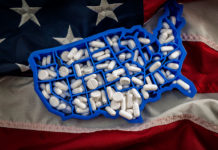A group of chemists, law enforcement officers, and medical experts at the United States Sentencing Commission this past Tuesday to provide testimony on the emerging health threats posed by synthetic drugs.
The meeting, focused on the fentanyl and so-called synthetic cannabinoids, was the third of this kind of hearings that the Sentencing Commission has held on the topic of synthetic drugs. The Commission is responsible for setting proper advisory guidelines for sentencing in the federal criminal justice system; 46 percent of the federal inmates are incarcerated for their drug offenses, the most common reason for incarceration.
Synthetic drugs, which usually are the work of illicit chemists, are distinguished from the drugs like heroin and marijuana and are produced by more traditional farming approaches.
“The concept of synthetic is if it’s man-made, versus something that is homegrown,” Dr. Roger Mitchell, the chief medical examiner of the District of Columbia, told. “So heroin is not necessarily synthetic because it’s made out of poppy, it’s manufactured out of a natural construct. Marijuana isn’t synthetic.”
Importantly, synthetic drugs allow the drug traffickers to avoid the blanket bans on certain kinds of drugs otherwise scheduled under the Controlled Substances Act by making several minor changes to the chemical structure of the drug that they want to sell.
“Currently, traffickers are again exploiting available legitimate research information on structure activity relationships, making small changes to the chemical structure of fentanyl and distributing these fentanyl analogues in the illicit drug market,” explained Dr. Michael van Linn, a drug scientist with the DEA.
The opioid fentanyl — a substance that is 50 to 100 times stronger than morphine — and its analogues make up the deadliest synthetic drugs, responsible for more than 20,000 deaths in 2016.
Chemists speaking to the Sentencing Commission further explained the proliferation of fentanyl analogues, designed to dodge the current regulations. Those analogues include drugs like carfentanyl, used as an elephant tranquilizer, just 50 micrograms of which may constitute a lethal dose, and ocfentanyl, which is 6,300 times stronger than regular morphine.
Last month, the DEA took action to fight the spread of fentanyl analogues, pre-emptively scheduling all such drugs under the Controlled Substances Act and easing the burden that is faced by the federal prosecutors.
Synthetic drugs are not new, but they have taken off in very recent years. Data that was released on Tuesday by the Customs and Border Protection agency further highlighted the rise of synthetic drugs in transnational drug trafficking.
As much was reflected in the testimony of many of the experts. Major Juan Colon of the New Jersey State Police also explained that the use of Naloxone a.k.a. Narcan, a drug that is used to reverse the opioid overdoses had risen from 5,000 instances in 2014 to over 12,000 in 2017, largely thanks to fentanyl. Robert Perez, who is representing the CBP, confirmed that fentanyl was indeed the most commonly seized drug in 2017.






























